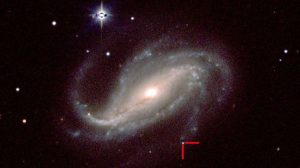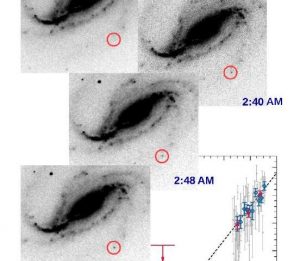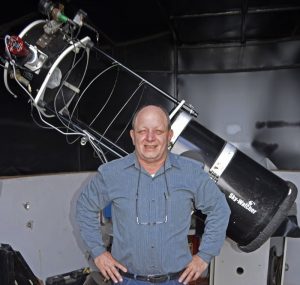Supernovas are among the most energetic events in the entire universe. A star, at least five times the mass of our Sun ends it’s life in a tremendous explosion that for a few weeks can be as bright as an entire galaxy of 100 billion stars. Supernovas are so bright in fact that they are usually observed and studied in other galaxies sometimes billions of light years away. Supernovas are also one of the most keenly studied class of objects in the Universe with astronomers and astro-physicists searching tirelessly for any new scrap of information, any new observation.
Now supernovas might be very bright, but usually they’re also very far away and since they occur randomly anywhere in the sky, they can often be hard to spot. The way that astronomers find a supernova is to compare a picture of a far off galaxy with a picture of the same galaxy taken a month or more ago. If a new star appears in the latest picture, you’ve got a supernova.
The problem with that technique is that astronomers have only ever seen a supernova several days or more after the explosion has taken place. They’ve never actually seen the first moments of the supernova explosion itself.
Until now, in September of 2016 an amateur astronomer named Victor Buso of Argentina was testing out a new camera with his 16-inch telescope when a supernova happened right in his field of view. Buso was taking one exposure every thirty seconds of a galaxy designated NGC 613 for a period of twenty-five minutes and managed to capture the rapid increase in brightness, what astrophysicists call the ‘Shock Breakout’ of the supernova. The image below shows an image of NCG 613 with the supernova bracketed by the red lines.

Supernova SN2017 gkg (bracketed by red lines) Credit: Carnegie Institute of Science, Las Campanas Observatory)
Four of the images captured by Mister Buso are shown below with the supernova, which has been designated SN 2016 gkg, inside the red circle.

Four of the Images Captured by Victor Buso of SN 2017 gkg (Credit: Victor Buso)
In the first image, labeled 1:44 AM, the supernova is not visible but in each of the succeeding three images it grows brighter. According to astronomer Alex Filippenko of the University of California at Berkeley, “Professional astronomers have long been searching for such an event.” Adding. “Buso’s data are exceptional. This is an outstanding example of a partnership between amateur and professional astronomers.” The image below shows Mister Buso proudly standing by his telescope, and he has a great deal to be proud about.

Victor Buso and his 16″ Telescope (Credit: Nature)
Once Mister Buso realized what he’d discovered he quickly contacted the Instituto de Astrofisica de La Plata in Argentina and within hours astronomers around the world were hard at work learning everything they could about Buso’s supernova.
Examining the spectra of the SN 2016 gkg enabled an international team of astronomers to determine that the supernova is a type IIb. The spectra of this type of supernova is rich in hydrogen and is the violent death of a star calculated to be five times the mass of our sun.
There are several well-known stars in our night sky that could be headed toward the same end as SN 2016 gkg. Betelgeuse and Antares are large, very massive stars that are approaching the end of their nuclear fuel and it is believed that they will both become supernovas ‘sometime in the next million years’.
Right now however scientists do not know how to predict exactly when a star will go nova but a lot of progress has been made in the last twenty years. (See my post of 11January 2017) Hopefully Victor Buso’s discovery of SN 2016 gkg will provide more data for astro-physicists to check their current theories against, and to help them generate newer, more accurate models of supernovas.
